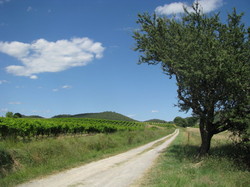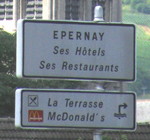Taking the slow way home
 By the time we got back to France, we’d reached the last few weeks of our journey – well, of the first half, anyway – and were feeling the need to slow things down a bit. Being constantly on the move has been very exciting, but it can get a bit wearing too; fortunately, we now had some opportunities to stay put for a while, and we took them.
By the time we got back to France, we’d reached the last few weeks of our journey – well, of the first half, anyway – and were feeling the need to slow things down a bit. Being constantly on the move has been very exciting, but it can get a bit wearing too; fortunately, we now had some opportunities to stay put for a while, and we took them.
This also meant opportunities to get into kitchens and do some home cooking for the first time in a while, and we took them too. That meant finding good quality ingredients – but this being France, that really wasn’t very difficult. Every small town and village we visited had a good food market at least once a week, and usually more than one butcher, baker and greengrocer. Not only will the shopkeepers and stallholders sell you excellent produce at reasonable prices (compared to the UK, at least), they’ll make sure you know how to cook it. In fact, we even got the impression they wouldn’t sell us their ducks or celeriac if they weren’t satisfied that we’d treat them properly …
Our first night started badly – we crossed the border from Italy at speed, drove underneath Monaco without even noticing, and were generally making excellent progress towards our intended destination in the Languedoc, when they suddenly closed the motorway. After about four hours of queueing to get off it, we found our way to the nearest town and its grotty hotel, and discovered that there was only one restaurant still open – and that only just. Fortunately, this being France, they served us a delicious plate of rouget, and some nice (and cheap) local wine; then we got up in the morning to find that it was market day, and bought a week’s worth of excellent fruit and vegetables. Who says French food isn’t what it used to be?
 Setting off west again, we realised that the delay had landed us at the beginning of Bastille Day weekend, the traditional French festival when everyone goes to park their car on the motorway. Fun as that was, we eventually called it a day when we arrived in Quissac for a rendez-vous with friends and family at Villa Plantat. We spent a lovely week here: the village fête meant we filled the first few days with pastis, pétanque and bull-running (watching, not doing), while trying to trick Robert, Sarah, Rhona and the two Dans into drinking all the rakı, ţuică and travarica we’d brought back from Turkey, Romania and Croatia. The second half of the week was spent celebrating Frances’ birthday with story-telling, walking, swimming and duck-braising.
Setting off west again, we realised that the delay had landed us at the beginning of Bastille Day weekend, the traditional French festival when everyone goes to park their car on the motorway. Fun as that was, we eventually called it a day when we arrived in Quissac for a rendez-vous with friends and family at Villa Plantat. We spent a lovely week here: the village fête meant we filled the first few days with pastis, pétanque and bull-running (watching, not doing), while trying to trick Robert, Sarah, Rhona and the two Dans into drinking all the rakı, ţuică and travarica we’d brought back from Turkey, Romania and Croatia. The second half of the week was spent celebrating Frances’ birthday with story-telling, walking, swimming and duck-braising.
 Food took up a lot of the time – cooking, eating, shopping – but it was time well spent. The local baker not only made good bread and viennoiserie, but their own rillettes and paté. The market in the next village had some of the best tomatoes we’ve seen on our trip. And the local vineyards kept us well supplied with rosé. We even broke with regional convention occasionally, using some of the mastic we’d brought from Greece to make some fine pots de crème, and using some chocolate sauce and banana pancakes to decorate Becky’s face.
Food took up a lot of the time – cooking, eating, shopping – but it was time well spent. The local baker not only made good bread and viennoiserie, but their own rillettes and paté. The market in the next village had some of the best tomatoes we’ve seen on our trip. And the local vineyards kept us well supplied with rosé. We even broke with regional convention occasionally, using some of the mastic we’d brought from Greece to make some fine pots de crème, and using some chocolate sauce and banana pancakes to decorate Becky’s face.
 The week ended all too quickly – thank you so much to everyone for coming to join us – so we decided to hide from reality just a little longer by heading up to the Alps to stay at Kate and Simon’s house in Mieussy. It’s a big change from the Languedoc to the Haute-Savoie, of course (I know which wine I prefer, for one thing), but the admirable aspects of French food culture still seemed to apply. The local markets were there, and full of excellent produce – all local, of course, so we were buying mountain saucisson, beaufort and abondance rather than goose rillettes and duck legs. The primary school had professional cooking classes, where they were allowed to try raw egg yolks. The local dairy made & sold fantastic unpasteurised cheese, butter and milk. And we discovered the wonders of crozidioflette, while Barnaby tried citron pressé.
The week ended all too quickly – thank you so much to everyone for coming to join us – so we decided to hide from reality just a little longer by heading up to the Alps to stay at Kate and Simon’s house in Mieussy. It’s a big change from the Languedoc to the Haute-Savoie, of course (I know which wine I prefer, for one thing), but the admirable aspects of French food culture still seemed to apply. The local markets were there, and full of excellent produce – all local, of course, so we were buying mountain saucisson, beaufort and abondance rather than goose rillettes and duck legs. The primary school had professional cooking classes, where they were allowed to try raw egg yolks. The local dairy made & sold fantastic unpasteurised cheese, butter and milk. And we discovered the wonders of crozidioflette, while Barnaby tried citron pressé.
 And July is when lots of things come into season in the mountains. The cows are up in their summer pastures, churning out creamy nutty Abondance cheese while generally looking and sounding absurdly picturesque.
And July is when lots of things come into season in the mountains. The cows are up in their summer pastures, churning out creamy nutty Abondance cheese while generally looking and sounding absurdly picturesque.  Isabelle’s co-operative allotment was producing ripe whitecurrants to be made into jam. And while walking in the mountains (mainly to find more cheesemakers) we could fill our pockets with green walnuts, which we took home to make nocino according to Giulia’s recipe.
Isabelle’s co-operative allotment was producing ripe whitecurrants to be made into jam. And while walking in the mountains (mainly to find more cheesemakers) we could fill our pockets with green walnuts, which we took home to make nocino according to Giulia’s recipe.
We could have spent weeks (or longer) doing this, but we’d run out of time: we had to get ourselves back to the UK to start the vaccination, visa-paperwork and car-modification marathon we needed for the second half of the trip. So we packed up & headed for Calais.
 It would have been silly not to stop in Burgundy on the way, though – we spent a night in the aptly named Bouze-lès-Beaune, went cycling through a string of villages named after our favourite wines, and learnt how to make mustard the traditional way at Moutarderie Fallot. (Anyone can call anything Dijon mustard, by the way – it won’t necessarily have been anywhere near Dijon – so look for moutarde de bourgogne if you want something that’s really made in these parts. Although the mustard seed will still almost certainly have been grown in Canada).
It would have been silly not to stop in Burgundy on the way, though – we spent a night in the aptly named Bouze-lès-Beaune, went cycling through a string of villages named after our favourite wines, and learnt how to make mustard the traditional way at Moutarderie Fallot. (Anyone can call anything Dijon mustard, by the way – it won’t necessarily have been anywhere near Dijon – so look for moutarde de bourgogne if you want something that’s really made in these parts. Although the mustard seed will still almost certainly have been grown in Canada).
 It probably would have been silly not to stop in Champagne, too – especially if you get to stay in an actual champagne house where they’ll take you (and Barnaby) round the cellars (after filling those with slightly better French than us in on all the scandalous local gossip). And Epernay’s famous restaurants, despite the less-than-promising signs on entering town, actually do a mean tripe andouillette.
It probably would have been silly not to stop in Champagne, too – especially if you get to stay in an actual champagne house where they’ll take you (and Barnaby) round the cellars (after filling those with slightly better French than us in on all the scandalous local gossip). And Epernay’s famous restaurants, despite the less-than-promising signs on entering town, actually do a mean tripe andouillette.
And that was more or less that: the next day we were on the Calais-Dover ferry trying to avoid looking too hard at the buffet (or at its prices, at any rate). Now for sunny Kent …

 Follow
Follow
Comments are closed